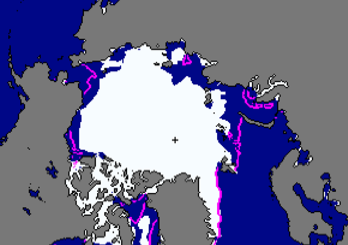The National Snow and Ice Data Center (NSIDC) just released figures for July’s arctic sea ice averages. The bad news: Last month’s average arctic sea ice extent is the second-greatest loss of summer sea ice since satellite tracking began in 1979.
Arctic sea ice extent basically measures how far sea ice stretches over the Earth’s surface. It includes any satellite data cell with a surface that is 15% ice (opposed to cells that have less surface ice and more water). In case you want to geek out further on the definition and process of these measurements, the NSIDC fleshes it out here. (It should also be noted that sea ice is not the same as glaciers, icebergs, or other frozen masses that float in the ocean. Sea ice is simply frozen ocean water, and is usually covered with snow.)
Though the impact of the disappearing ice is much more extensive than the short list below, here are a few effects that have manifested as of late:
1) Life is becoming more difficult for indigenous populations.
Indigenous tribes like the Inuit and Yup’ik are finding it more difficult to hunt, harvest, travel, and conduct daily life as the sea ice grows thinner. The northern communities depend on the hard surface for everything from food to recreation. But the ice is not simply a surface to walk on. Ice conditions are traditionally used as an indicator for safety and food acquisition. As does many other traditional weather indicators, changing ice makes survival increasingly difficult. Sea ice accidents are more common as the amount of thicker ice dwindles. People are falling through ice or getting stranded on break off pieces more and more often. Though the ice is always moving, melting, and growing back, Inuit leaders say the current changes are happening so quickly and in new ways that it is difficult to adjust. The sped-up fluctuation has inspired a long-term project, led by local scientists and community leaders, to archive cultural sea-ice knowledge and its relevant vocabulary, as well as to create safety-promoting trail maps.
2) The melting of sea ice is self-perpetuating.
Since white surfaces reflect light (a quality called albedo) and dark surfaces absorb it, more sea ice means more sunlight, or heat, is reflected off the Earth’s surface. While sea ice reflects fifty percent of solar radiation, the ocean only reflects about six percent. So as the sea ice area declines, the dark polar water absorbs more heat. This means that melting will eventually lead to elevated water temperatures, thus speeding up the sea ice decline, in turn heating up water even more.
3) Polar bears are drowning.
Just last week, wildlife biologist Charles Monnett, who published a 2006 paper [PDF] linking drowning polar bears to climate change, was canned. (Last week, Mother Jones’ Kate Sheppard reported the suspect details of that investigation and firing.)
But its not just polar bears that are being de-prioritized. Arctic foxes that use sea ice to escape predators are getting trapped with their nemeses on the diminishing surfaces; walruses have to swim farther to find breeding grounds; and Peary caribou are falling through unusually thin ice. This food chain disruption exacerbates problems for northern indigenous communities.
4) The shipping season in the Northwest Passage is expanding.
Arctic countries are seeing gold in those polar waters as the amount of time available for shipping through the Northwest Passage is increasing. Russia just approved funding for six new icebreaker vessels—3 nuclear-powered and 3 diesel-powered, Barents Observer reports. While it’s true that shipping through the Northwest Passage allows for shorter trips—read less carbon emissions—it also requires more vessels to make the trip, as the icebreakers are required for the journey. Icebreakers also create noise pollution that puts marine animals, like the beluga whale, at risk [PDF]. Then there’s the likely risk that as the north opens to such enterprises, the untapped resources will be more accessible for exploitation. But besides those speculations, icebreakers equal more sea ice breakup.
